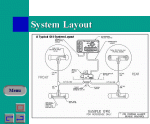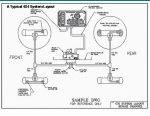motomacguyver
New member
- 269
- 5
- 0
- Location
- Eau Claire, Wi. USA
I have a few questions on CTIS Theory, not how to operate it, not how to remove and replace parts per the TM (I read that part). I’m interested in how it’s supposed to work at the design level so we can troubleshoot our problems more intelligently.
So here are my questions, and some observations of my own.
1st Question, What is the “signal” for the wheel valves to let air out? There is only one air line in/out and no electrical connection to the wheels, so this must be done pneumatically. How?
2nd Question, After raising the air pressure in the wheels, does the CTIS manifold “purge” the air out of the lines? I think it does, because the CM automotive web site says they took great pain to make sure the wheel bearing seals are not under pressure most of the time. Verification would be great.
3rd Question, Is the CTIS manifold capable of checking and filling pressures one circuit at a time? (There are 3 lines running out of the manifold, one for each axel.) Or is it able to “gross fill” all three circuits, and then isolate individual circuits and fine tune the pressures?
Finally, here is my reason for asking these questions.
When I deflate the tires, (go from highway to X-country) I get varying tire psi's, when I inflate, the tire psi is stable until it gets up to pressure, then the CTIS must purge the air lines, (the CTIS manifold seems like it lets out a lot of air at this point, maybe 20 seconds worth), and then my tire psi's are all over the place. This must be the tire valves not deflating correctly? Am I correct in this assumption?
Thanks in advance.
So here are my questions, and some observations of my own.
1st Question, What is the “signal” for the wheel valves to let air out? There is only one air line in/out and no electrical connection to the wheels, so this must be done pneumatically. How?
2nd Question, After raising the air pressure in the wheels, does the CTIS manifold “purge” the air out of the lines? I think it does, because the CM automotive web site says they took great pain to make sure the wheel bearing seals are not under pressure most of the time. Verification would be great.
3rd Question, Is the CTIS manifold capable of checking and filling pressures one circuit at a time? (There are 3 lines running out of the manifold, one for each axel.) Or is it able to “gross fill” all three circuits, and then isolate individual circuits and fine tune the pressures?
Finally, here is my reason for asking these questions.
When I deflate the tires, (go from highway to X-country) I get varying tire psi's, when I inflate, the tire psi is stable until it gets up to pressure, then the CTIS must purge the air lines, (the CTIS manifold seems like it lets out a lot of air at this point, maybe 20 seconds worth), and then my tire psi's are all over the place. This must be the tire valves not deflating correctly? Am I correct in this assumption?
Thanks in advance.





